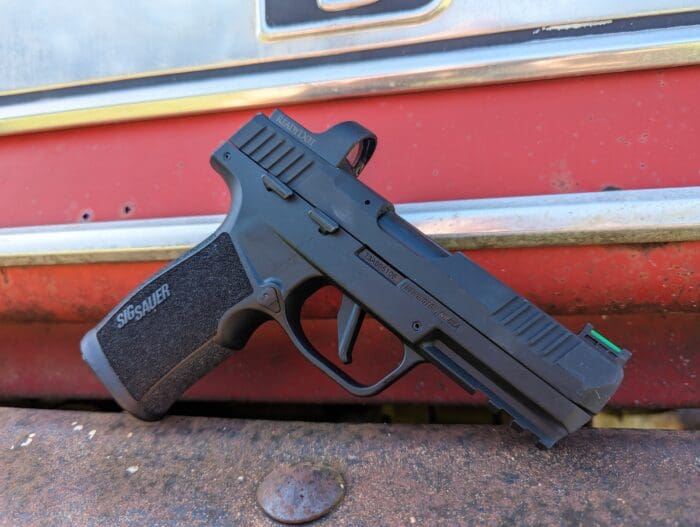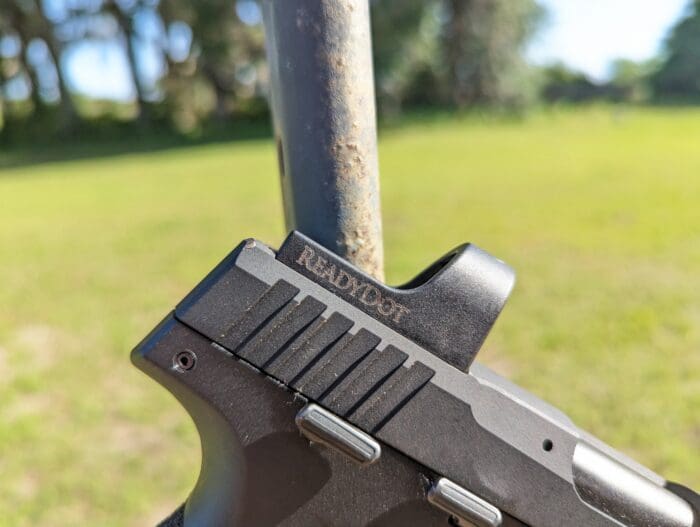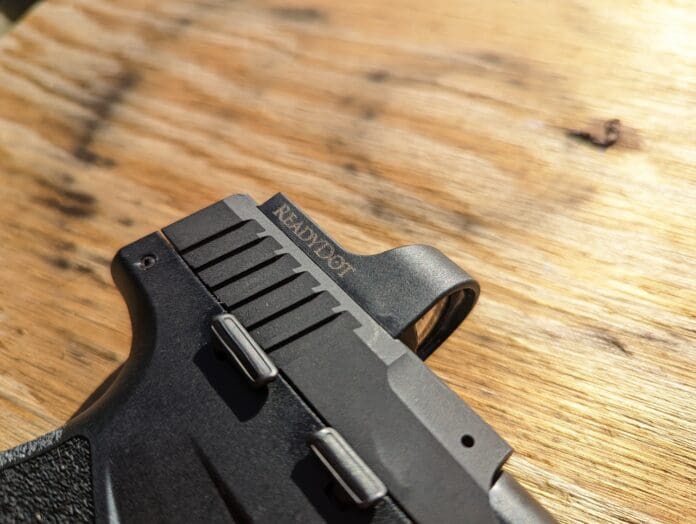The Ruger ReadyDot may have been one of the more controversial releases at NRAAM. Ruger releasing a red dot isn’t terribly unusual. They’ve made the Max-9 and Security-380 MAX pistol optics-ready, so why not provide the pistol and an optic? Red dots on handguns have become a standard, and they offer shooters a sighting solution that’s easier to use, faster to use, and can even increase your own effective range. The Ruger ReadyDot is designed specifically for the Max-9 series and utilizes the Shield RMSc footprint.
But Ruger’s red dot is unlike any other sight currently on the market and was met with a fair amount of flak mainly because the optic can’t be zeroed by the user (it comes factory-zeroed). It’s a lot like fixed iron sights on small guns like the LCP series. That wasn’t the only unusual aspect with the ReadyDot. You don’t have to worry about batteries for the ReadyDot because the optic doesn’t use any. Fiber optics absorb ambient light and power the reticle.

Those same fiber optics automatically adjust the brightness of the dot as needs be. That dot is also large. It’s a 15 MOA dot in a world where 6 MOA dots are considered big. With no battery compartment, the optic sits much lower than most optics. That allows it to co-witness with standard-height iron sights. To be fair, it’s designed to co-witness with Max-9 sights, so your mileage may vary.
One of the more appealing aspects of the Ruger ReadyDot is its price. At only $99 dollars, the ReadyDot isn’t going to hurt your wallet
But Does the ReadyDot Work?
That’s the big question everyone asked who heard about it. There are a few issues that I instantly thought of when Ruger announced the ReadyDot. Like most, I’ve never tried an optic that can’t be zeroed. Second, how will the ReadyDot’s automatic brightness adjustment work in weird lighting environments? Ruger sent me a ReadyDot so I could figure that out.
I mounted the ReadyDot on my SIG P322. The ReadyDot was designed for small, subcompact-sized carry guns. However, for testing, I wanted a gun I could shoot accurately, and I needed something with a rail to create some more interesting lighting situations.

Thus the choice of the P322 as a test platform. The ReadyDot has very simple packaging and comes with an Allen key, two bolts, and the optic. The bolts are aimed at the Max-9 but worked just fine on my SIG. I attached the ReadyDot without issue and hit the range.
Clarity and The Dot
Normally I’d tell you about the zeroing process and adjustments, but that isn’t an issue here. Again, there’s no adjusting the ReadyDot. Its 15 MOA dot is centered and that’s where it stays.
Instead, let’s talk clarity. Like every red dot ever created, the ReadyDot uses a lens coating to reflect the red dot back for visibility. What’s different here is how dark that coating is. This is called a notch filter, and it is a very dark blue.

Notch filters reflect the red light of the emitter, and the darker notch filter likely helps magnify the fiber optics-powered emitter that reflects the dot. It’s dark, but doesn’t necessarily affect visibility or clarity. It might have issues with night vision, especially with lower-tier night vision, but since this is a fiber optic powered sight, this isn’t a red dot anyone will be using with night vision.
The dot itself is impressively clear. It doesn’t starburst, even in bright light situations. It’s easy to see and perfectly round. For a sight at this price, it’s impressive. The dot also doesn’t lag or drag as you switch quickly from target to target or during the recoil of the slide.
The ReadyDot and Varying Light Conditions
Since the ReadyDot adjusts to the light around you, it suffers the same problem as the Trijicon ACOG fiber optic model. If you’re in a bright environment and aiming into a dark environment, you have a very bright reticle that can be annoying.
The real problem comes from aiming from a dark environment into a bright environment. In that situation, the dot disappears almost completely. If I aimed from inside my home out the window, the dot disappeared, and I couldn’t use it.

The ReadyDot works best where the shooter and target are in similar lighting situations. In super bright environments, the dot gets extremely bright and capable. It’s easy to see in the brightest environments. In darker environments, it gets quite dim and becomes transparent, but it can still be seen. If it’s so dark you can’t see the dot, you probably can’t see your target anyway.
In situations with a weapon-mounted light, there aren’t any problems using the ReadyDot. I used a Streamlight TLR-1 HL with 1,000 lumens of light. It didn’t wash out the dot, and honestly, the reflection of the light off a wall actually helped increase the dot’s brightness. The real problem comes into play when you are outdoors, in the middle of nowhere, on a dark night. If you turn the weapon light on, you can’t see the dot (as there’s little or no light for the fiber optics to gather), and there is nothing for the weapon light to reflect off of.
At the Range
Ultimately, can you hit your target? That’s what matters, after all. With the gun mounted and a B-8 waiting for me, I started at ten yards and slowly fired an off-hand group. While they were all in the black, and even in the ten ring, they weren’t in the X. (Ignore that flyer, that’s on me.)

I fired several more groups and even broke out a table to use as a rest. Regardless of how I shot, my group always landed slightly to the left. I held center on the target and applied zero Kentucky windage. At ten yards, it’s not bad and likely in the margin of error for most shooters.

Once I back out to 25 yards, the problem increased in severity. I remained on paper, but not even in the seven ring. At 25 yards, that big 15 MOA dot nearly covered the entire target, so to be fair, the dot was covering where I was hitting.
The ReadyDot Use Case
Ruger didn’t design the ReadyDot as a precision pistol sight. In fact, it’s the modern of the ramp sight on a J-frame. It can’t be adjusted, and with it’s big dot, it’s designed for guns that will most likely be used at very close ranges in defensive situations.
I admittedly prefer a dot I can zero and one with some degree of precision. Even on my P365 carry gun, I like being able to keep my rounds at least close to the X-ring.

The ReadyDot is made more for close-range, adrenaline-fueled self-defense situations. Point and shoot and distances where you just need to put the dot on the target to be effective.
Within most statistical self-defense situations, that’s certainly good enough. As someone who has helped others zero their subcompacts guns and red dots, I know a lot of average concealed carriers can’t produce a group consistent enough to zero beyond 10 or 15 yards.
That’s where the Ruger ReadyDot finds its place and where it works. I personally prefer the ability to get a nice tight zero on my red dot. But if you want an out-of-the-box solution that’s very affordable and doesn’t require much effort, the Ruger ReadyDot works.
Ruger’s best move would be to sell them pre-attached to Ruger Max-9/Security-380 guns and take all the effort out of the process. Oh…they’re actually doing that already.
Ratings (Out of Five Stars)
Clarity * * * *
The dot is quite crisp and easy to see, and besides the heavy notch filter, I was fairly impressed by the clarity of a $99 dot.
Ease of Use * * * * *
All you have to do is install it. Period.
Reliability * * *
I had no problems with the dot working mechanically. The only problem came from a few situations where the fiber optics couldn’t properly illuminate the dot given the lighting situation, like outdoors with a weapon light on a dark night or when aiming from the dark into a bright situation.
Precision * *
I’m impressed it was that close without the need to zero. Being off an inch or so at ten yards right out of the box is good for any red dot. Elevation wasn’t an issue, but clearly, windage is. A
Overall * * * ½
Again, the Ruger ReadyDot is the modern version of J-frame sights. It is what it is. With its big 15 MOA dot and lack of adjustments, it’s made for close-in self-defense situations and will be very effective in that role. Its lack of electronics and adjustments make it very affordable. Just don’t expect to use it for precision shots at distance.





Appears to have extremely limited usefulness.
Thank you for the article…think I’ll pass.
I listened to different humans telling me h0w a go0d deal of cash they may make online,N255 so I was determined to l0cate out. Well, it turned into all actual and it absolutely modified my life. Everyb0dy must try this job n0w by
just using this site……… https://www.cutt.ly/C6ngsKC
Quit listening to humans. You’ll be much happier.
Presently You’ll gain Up To from 99000 Bucks A Month! There are no impediments, Be Your Possess Boss, it All depends on you And how much you want to gain each day. Typically a veritable and ensured strategy at no cost to gain a colossal entirety of cash at domestic. Connect this right now…… https://richepay.blogspot.com/
Please! What a fucking joke
A red dot designed for point shooting distances. Genius! /sarc
with my reading light clamped onto the bill of my kum & go ball cap it works just fine in near darkness. and with my jetbeam sos strobing under my coctail glass i should have another pretty soon now.
felize viernas.
I have made $18625 final month by w0rking 0nline from domestic in my portion time as it were. Everyone can presently get this j0b and begin making dollars 0nline fair by take after points of interest here..
:
) AND Great Good fortune.:
)
HERE====)>>> https://homejobs504.blogspot.com/
The ReadyDot was made specifically to co-witness with the Ruger Max-9 stock sights when mounted on that gun mounting system which is why its fixed.
Its ‘geometrically’ ‘zero’d’ internally mechanically so its dot is in the optical center all the time parallel to the bore horizontally and vertically (in a straight line) and the lower profile brings that optical center down so it co-witnesses with the MAX-9 stock sights when mounted on that gun mounting system.
You’ve seen this concept employed before. For example, in the Meprolight FT Bullseye sight where the dot, once you physically align the gun (while sighting) such that the dot is in the circle center, is then parallel to the bore vertically and horizontally. This is also the same principal employed for laser sights that are set up for proper parallel zero. The difference between the Meprolight FT Bullseye and the laser sight is that the laser sight has windage and elevation adjustment so you can set up for the zero you want and the Meprolight doesn’t, but when the laser sight is set up for correct parallel zero it is parallel to the bore like the dot on the Meprolight and the Ruger ReadyDot is so in that aspect all three would use the same type of zero which is a parallel zero.
All of you who have purchased a quality manufacturer (most manufacturers) dot sight have seen this basic principal used when you first take take the sight out of the box and turn it on, the dot is ‘geometrically’ ‘zero’d’ such that the dot is in the ‘optical center’ (unless pre-zero’d for a certain distance, usually 50 feet when that happens). Except on those its adjustable by the W/E adjustments and not fixed internally like the ReadyDot.
(note: The reason for this 50 foot zero some manufacturers use is because it brings the dot close to a parallel zero relative to bore center at 89.5 degrees on a firearm and that makes it useful for close range engagement out of the box while not deviating too far beyond the 50 foot zero point to miss a man sized target completely out to about 20’ish yards. But still, even if a dot sight is not factory ‘zeroed’ at 50 feet but the dot is in geometric center (optical center) they are still “useful” out of the box for close engagement of out to about 10 – 15 yards on a man sized target to put rounds on target somewhere.)
Wasting precious life or death fractions of a second to acquire a red dot while engaging a threat at 10-15 yds is a fools errand. A red dot sight has no substantive benefit inside 15 yds, so if the ReadyDot has diminished accuracy past 15 yds it’s junk. If the ReadyDot can’t be pre-zeroed to allow center of target accuracy at 15-25 yds on Max-9 and Security-380 pistols when they leave the Ruger factory, then the sight is junk.
Since the primary usefulness of red dots is noticeably enhanced accuracy past 15 yds, who in the hell would want a non-zeroable red dot that requires Kentucky windage for X ring accuracy at 10 yds? I can’t believe Sturm, Ruger, & Co. would actually tarnish a legacy of functional quality with such a sketchy product, Bill Ruger is rolling over in his grave. If they are willing to sell junk like the ReadyDot, what other junk are they willing to pedal using the Ruger brand?
Ruger Wranglers
Since I evidently suck at zeroing anything, I’ll have to say this is interesting.
I really liked a lot of the article, including explanations of factors that I wouldn’t necessarily have figured out myself.
OTOH, I don’t like the analogy to J-frame sights (which add practically nothing to the revolver’s size or cost). I may be missing something, but some highly visible adjustable fiberoptic sight sets are both cheaper and a good bit smaller than this.
I quit using any kind of sights years ago when I discovered no matter what sight I use the intended target is safe. That’s one reason I like an AK, built in excuses. If I put a scope on a million dollar baby the excuse goes out the window.
possum:
I can depend on you for a good laugh every time. Thanks for making my day with this one!
Doesn’t work at night. Can’t be adjusted. 15 MOA dot nearly covered the target. Heavy blue tint. What’s not to like? Oh, the price? 99 bucks?
You get what you pay for. Buy once, cry once, and get something decent.
THANKS FOR INFOR ALWAYS
It looks like they’ve got something very close to working well. Closer than I would have expected.
If they can add windage and elevation adjustment I’m interested. I also want at least once report on compatibility with at least medium grade astigmatism.
I’m interested but will wait for the Gen 2 or 3 version.
This optic is stupid and anyone who buys this dot is stupid.
How tf can you release a non-adjustable optic?
It would be easy to make horizontal adjustments utilizing a laterally pivoting mount. Bausch $Lomb offered a similar feature on their Balvar series of scopes and it worked well.
Another red dot, that is great to use.
Comments are closed.